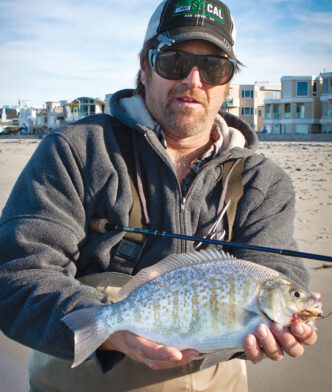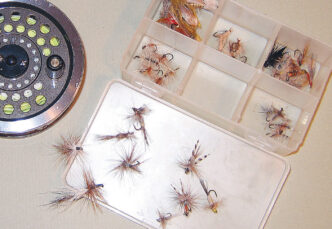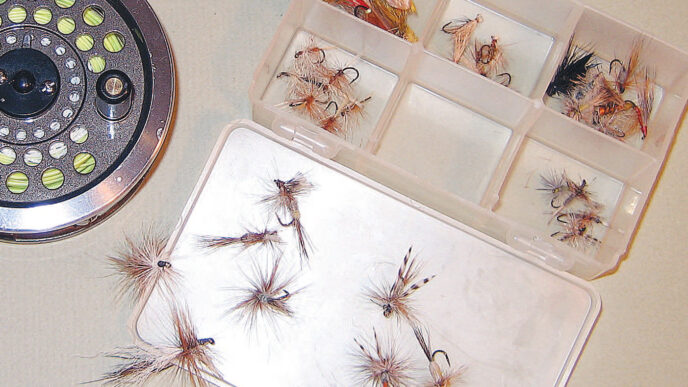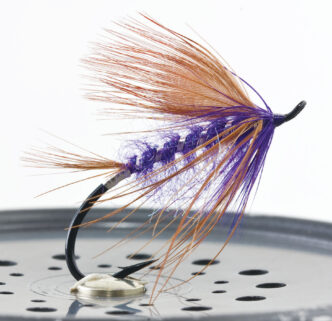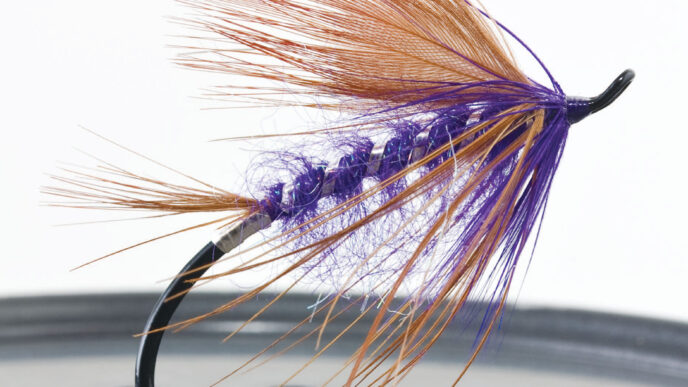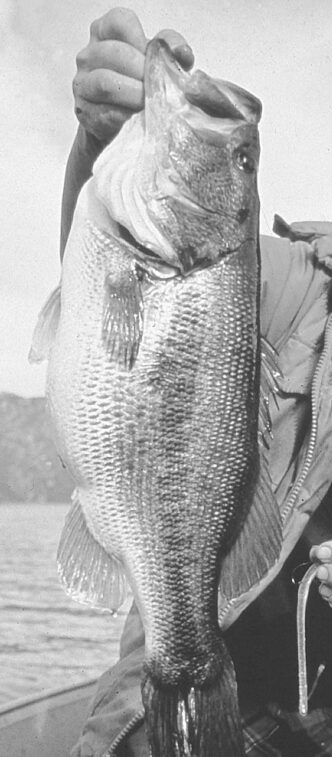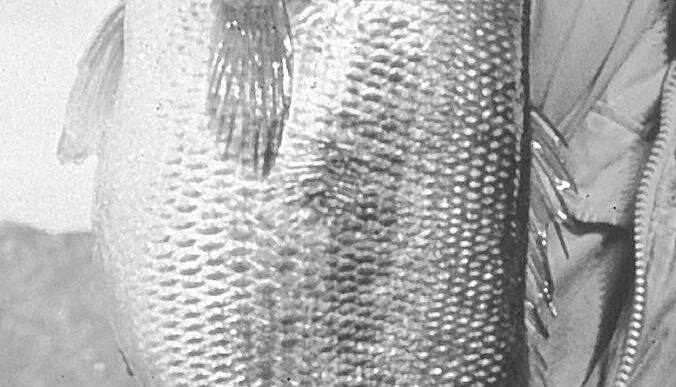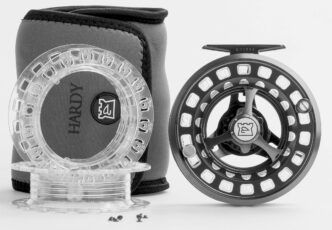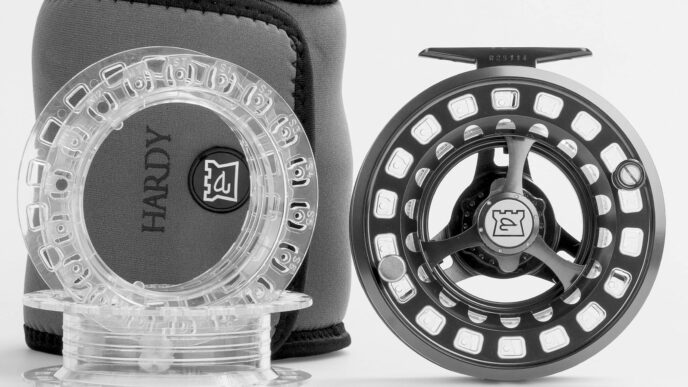From the sour buzz I was hearing over the summer, I wasn’t expecting much from August’s International Fly Tackle Dealer Show. Dealer interest was reportedly low, and a number of manufacturers had reputedly decided not to exhibit. But for those of us who cruised the aisles of the Reno Convention Center, the major players in the fly-fishing game were in attendance (minus G. Loomis and Lamson and just a few others) and showing off a surprising amount of really interesting new gear. I’ll cover new fly rods in this issue.
At the Premium Pump
After years of putting fast-action rods at the top end of their offerings, both in level of finish and in price, the folks at Sage have pulled a neat switcheroo. The new $745, top-of-the-line Sage Circa models are Slow, which is to say there’s a lot of flex in the butt, flex that you’re quite aware of while casting. But Circas are not Slow like your papa’s glass rods, but rather Modern Slow, with an emphasis on delicacy and accuracy and with a light enough swing weight to please the modern angler. Were I a cynic (heaven forbid), I’d suggest that this was simply a brilliant marketing ploy. I mean, what do you do when you’ve virtually defined and owned the light, fast action rod market? If you keep introducing new fast rods, you’re constantly tripping over the corpses of your past efforts. The answer, if you’re as savvy as the folks on Bainbridge Island, is to change the playing field by developing and arguing persuasively for the virtues of a new, slower rod that lets the angler fish effectively at a more stately, mellower pace. But if you’re Sage, it’s not just marketing. These guys design excellent fly rods, and when they set out to build a slow rod — chucking the ball cap for a fedora, so to speak — they create a slow rod that modern anglers are sure to like.
They do it by using relatively small diameter mandrels in combination with modern composites and proprietary ways of combining them to get bend without vibration or lateral flex. They add a bit of mass to the tip by using relatively large snake guides, so the butt is made to flex even more. Put a Circa next to another Sage — a One, for example, or a TCR, or an old RPLX — and you’ll be struck by how skinny the blank is. Wiggle it, and you’ll immediately sense how fully the rod flexes down into the grip.
But how does it cast, you ask? The 8-foot 9-inch 5-weight Circa I tried was very nice, a rod with which I’d be happy to fish. Accuracy at short distances can be a problem for a rod that doesn’t initiate its flex in the tip, but this Circa was solid at 20 feet, tracked nicely extending line, and could be pushed to 70 feet or so — a distance much longer than most of us will find ourselves casting to trout — with ease. The 7-foot 9-inch 4-weight I cast was also pretty good, but I preferred the other rod — personal taste, perhaps, or maybe there’s just so far you can go with reducing blank diameter to get bend.
Sage Circas are all four-piece and are available as 7-foot 9-inch rods in line weights 2, 3, and 4, and as 8-foot 9-inch rods in 3, 4, and 5 line weights. They’re a classy dark green color, with olive wraps tipped in gray, use a handsome verawood uplocking reel seat with the snub-nosed Wells grips Sage introduced on the TXL series, and come packaged in a slim “desert gold” rod case and a snazzy cloth bag that shimmers between gold and green. (A modern product can’t be too traditional, you see.) If you’re tired of strong-butted rods, want to relax a bit without sacrificing effectiveness, and want to experience the sweet feel that’s mostly associated with bamboo and fiberglass, you’ll want to give Circa a try. It won Best of Show in Reno, by the way, in a field with some pretty tough competition.
Hardy’s Proaxis rods got all sorts of press over the past couple of years. It was not simply that Hardy utilized the extra strong 3M-sourced resin system that Hardy, in combination with proprietary composites, calls Sintrix, but also because Proaxis rods provided exceptional performance. They weren’t cheap at just under $700, but they weren’t the most expensive toys in the closet, either. For 2013, Hardy has come up with new Proaxis models for 10-weight, 11-weight, and 12-weight lines that differ from the basic Proaxis only in having a no-frills “ProGuide” reel seat. They are available in both four-piece and one-piece versions at the same mid-to-high-$600 prices.

For the angler who simply must have a British-built rod to go along with his or her British-built reels, Hardy has introduced the Artisan Sintrix models. Made in Alnwick, England, with Sintrix resin blanks and the finest fittings and finish, instead of in Korea, like the Zenith and Proaxis models, these babies go for $1,199 to $1,499 in single-hand models. Santa may sputter a bit when he gets your request for an Artisan Sintrix, but leave some bangers and mash under the tree, and he’ll likely jolly right up again.
Sage also jumped into that superhigh price range, one previously occupied only by bamboo rods, with the introduction of the $1,295 Sage One Elite. This partly custom-built rod, with spare tip, titanium reel seat, laser-etched logo end cap, titanium stripper guides with ceramic inserts, and titanium winding check, is offered in only a 9-foot 5-weight option in a classy black tube. Given how easily we anglers are persuaded of value and the market’s interest in “collectibles,” I’m betting Sage will sell a bunch of them.
Another strong rod launch for 2012 is the Orvis H2 . . . a pretty thorough revamping of Orvis’s popular and successful Helios line. “Why mess with what works?” asked Orvis’s marketing guy Tom Rosenbauer when the rod builders told him that they were dumping the Helios. Trying the H2s, he soon agreed that they really are an improvement.
Built on new tapers in slightly larger diameters to enhance smoothness of delivery and accuracy, H2s use a new proprietary material integrated into the tip. When I asked what that material is, all I got was a grin and a story about close ties with hotshot engineers and material fabricators and blood oaths sworn to stay silent. According to Orvis, H2 isn’t simply about new materials or improved casting and fishing performance. The rod offers a 20 percent reduction in weight and 100 percent better impact resistance than the original Helios — which is to say, it will not only be light in hand, it will also be less likely to break when you whack it with a weighted fly (a problem when rod designers choose to go light).
What matters, of course, is how well the H2 performs when fished. I didn’t get to cast a trout-weight rod at the show, but trustworthy friends report that they’re light, quick, and smooth. I did, however, beg an H2 10-foot 7-weight loaner for a late-September steelhead trip on the Klamath. While short casts with a floating line weren’t quite as smooth as I would have liked, this H2 was the real deal with long casts, sink tips, and shooting heads, which is mostly what that class of rod is going to be used for. I suspect it will be a heck of an indicator rod, too. I wish I could say I had the opportunity to test the rod’s impact resistance, but the thought of a premium-priced loaner either made me uncharacteristically careful or I mistreated the rod and it never told me so by failing.
H2 blanks are finished with a handsome blue UV-resistant coating, gray wraps, crushproof REC Recoil guides, and supergrade cork handles. The freshwater models have California buckeye burl inserts under black nickel skeleton hardware. The saltwater models use a blue woven graphite insert. Orvis lists 18 freshwater models and 13 saltwater models, all four pieces save for one 6-foot three-piece 2weight. The length and line weight configurations, in both Mid-flex and Tip-flex actions, cover just about every desirable configuration. Thirty-one new models is quite a lot, and Orvis is staggering the H2 launch, with just 4 models available in November, a dozen more coming out in January, and 15 more again in April. Freshwater rods are priced at $795, while saltwater models cost $850.

R. L. Winston, which quietly keeps producing handsome, glossy green, high performance rods in Twin Bridges, Montana, won a Best Saltwater Fly Rod award for their new Boron III-SX models. The SX designation is meant to indicate a superfast action. Winston is billing BIII-SX rods as “big-game” rods for any extreme fishing situation. While fast and with tremendous lifting power, BIII-SX models, according to Winston, still retain a very responsive feel while casting. Now, Winston winning an award certainly comes as no surprise, but the fact that the BIII-SX family — all of which are 9-foot four-piecers — includes 4-weight, 5-weight, and 6-weight freshwater models makes that an interesting choice. Then again, what constitutes “big game” and an “extreme fishing situation” can depend on the situation and the fish involved.
BIII-SX models in lighter line weights are built with cigar-shaped grips and nickel-silver and burl-wood uplocking reel seats. Slightly oversized full Wells grips come on the 7-weight through 12-weight models (and on one 6-weight option), which feature lightweight matte-black anodized all-metal seats engraved with the R. L. Winston script logo and short fighting butts. They all feature oversize matte finish titanium-coated snake guides for low glare and easy clearing of line/leader/backing connections. Prices range between $795 and $895.
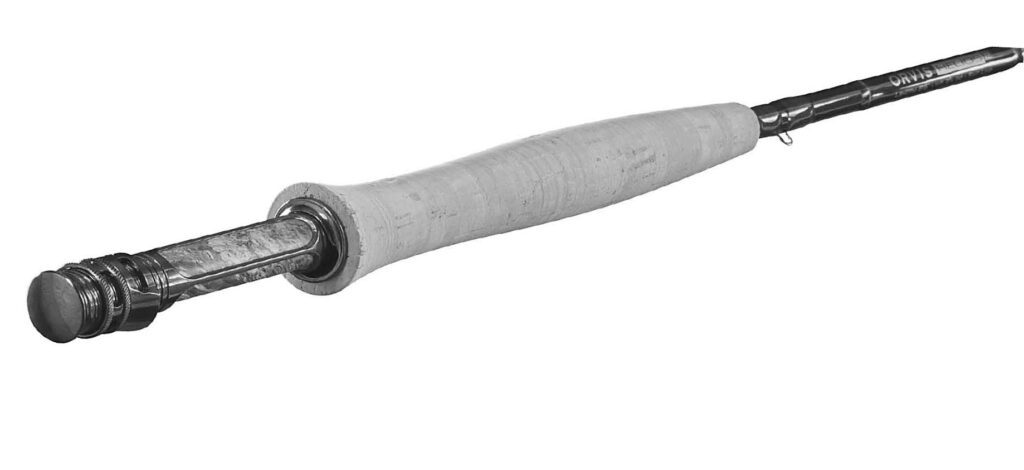
Thomas & Thomas, under a new owner determined to put the company back in the game, wasn’t at the show, but recently announced a new line of medium action four-piece small-stream rods that go by the name ESP. At 7 feet 6 inches and 8 feet for 3-weight, 4-weight, and 5weight lines, ESPs have clear (which is to say, glossy black) graphite blanks, chestnut wraps with black tipping, a new lightweight reel seat with a tiger maple insert, and black nickel snake guides. They’re $730. Thomas & Thomas also added a fast-action 6-weight NS model for bigwater trout, light steelhead, and grilse fishing, which is priced at $820. T&T, while never really catching on in the West, has always built rods that cast commendably well, and they do just about the nicest finish work of any rod company. It will remain to be seen if their new efforts justify their premium prices.
Some Wallet Savers
Not every good fly rod costs $600 or more. There are a handful of new rods in the middle ground between that price and $150 that bear mentioning. Some are made offshore, some in the USA, and they all have many of the features that characterize more expensive rods.
A couple of years ago, Winston started selling an American-made middle price-point rod, the four-piece GVX series, at $495. It was built on the same tapers as their more expensive boron/graphite models, but was all graphite and used less expensive components. It was a winner, from what I heard. This year, Winston has reworked the GVX into the GVX-Select series, using upgraded cork, an upgraded rosewood-insert reel seat, and a nicer green aluminum case. There’s a 7-foot 6-inch model for a 4-weight line, 8-foot 6-inch models for 3-weight and 4weight lines, and 9-foot models for 4weight through 8-weight lines. The price is now $545 for 3-weights through 7-weights and $565 for a 9-foot 8-weight. Few rods are smoother than all-graphite Winstons.
Redington, always a strong player in the affordable-rod game, introduced a new family of rods they’re calling Link. Links use new lightweight graphite layups and carbon-fiber-weave overlays at ferrules and the butt section to improve power, and they come in a sexy carbon-fiber rod tube with a bright blue cap and end plug. There are 15 four-piece models in lengths of 9 to 10 feet for line weights 3 through 10, all priced at $349.95.
Redington has created what must be the most complete beginner’s outfit in the game. The new Topo outfit includes a 9foot 5-weight four-piece rod and Crosswater large-arbor reel, a matching weight forward line, a leader, an extra spool of tippet, half a dozen useful flies, and a nylon rod/reel case. Just add fish and water. At $199.95, Redington bills it as the perfect “grab and go” outfit, which it just may be.
Sage replaced its Flight and Advantage lines of midpriced to low-priced rods with two new models: the fast-action Response at $395 and the medium-action Approach at $295. Both series are fourpiece rods offered in numerous useful length and line-weight combinations and are made in the USA. There’s also an Approach line of outfits that combines 9-foot 4-through-9-weight rods with compatible Sage 1800 fly reels and RIO Gold weight forward fly lines for $475 to $495. Thirty years ago, either of these rods would have been top of the class . . . but back then, nobody could cast or catch fish like we can today, could they?
Echo, which up till now has concentrated on the $200-to-$350 price points and four-piece rods, has joined Hardy in offering one-piece saltwater rods. The 8-foot 10-inch Prime rods, in line weights 8 through 12, have fast actions, blue gloss blanks, black wraps, premium-grade cork grips, and lightweight all-metal reel seats with fighting butts. The 11-weights and 12-weights also have foam assist grips. Of course, at 8 feet 10 inches and no ferrules, it will help if you have a car, boat, or garage where you can store the rod. I’m looking at 9-weights through 12-weights for my palatial homes in Juneau, Marathon, Biloxi, and La Paz, but I suppose I’ll have to drive the rods there, because they’re too long for my airplane. The Echo Prime is priced at $549.95.

Adamsbuilt is a new name in the fly game, split off from but still associated with Hendrix Outdoors, a longtime Nevada distributor of fly-fishing gear. They now have a nice selection of medium priced fly rods, including the new C4 series that are priced between $299 and $379, depending on the model. And in an interesting approach to online sales, Adamsbuilt will complete online orders with shoppers via the Shopatron e-commerce platform, collect all payment and shipping information, then pass those orders to a local shop for fulfillment. The idea is to reach the larger Internet market via the Adamsbuilt website while still benefiting dealers and improving brand loyalty. A neat touch.
L. L. Bean, looking to attract the attention of indicator nymphers and singlehanded steelhead anglers, has added new 10-foot four-piece models for line weights 4 through 8 to their mid-priced Silver Ghost series. Light in weight, silver in appearance, as you’d expect, with nice components and a carbon rod tube, they’re priced at $315.
Cabela’s introduced a line of short fiberglass fly rods a year or so ago — the Cabela’s CGR (you figure it out) — and reportedly sold thousands of them at the entirely reasonable price of $99.95. There was nothing special about them in the way of looks or the quality of their components, but they cast pretty nicely. And they were $99.95. For 2013, Cabela’s has redesigned the tapers and the materials, added $50 to the price, and come up with the CGt. I haven’t cast the new CGt, but their appearance has improved, with translucent brown blanks and better cork on model-specific grips. The 7-foot 6-inch 7/8 weight CGR, which I thought was a neat idea as a canoe or kayak rod for bass, has been dumped, but there are five other CGt models from 5 feet 9 inches to 7 feet 6 inches for line weights 2 through 5. At $149.95, they still represent a bargain for the angler who wants to fish a rod that bends.
Two-Handed Rods
Double-handed fly rods continue to provide anglers with real choices as rod companies look for different solutions to the variety of ways in which anglers fish the long rod.
Scott’s new T3h two-handed and switch rods, like a number of Scott rod families over the years, have a “natural” unsanded finish and feature relatively large diameters and thin walls. That approach, according to Scott, makes both for light weight and the requisite stiffness to handle casts and fish while retaining liveliness and feel. The danger here is that thin walls, improperly designed, can be fragile. Scott solves that with technologies they call XCore and ARC, which combine advanced multiple-modulus composites and proprietary fiber orientation to provide toughness and durability — and of course, by not sanding off outside fibers.
The new T3h series are medium-fast rods that Scott argues can effectively address your fishing “whether you skate, swing, or dredge.” There are T3h switch rods at 10 feet 6 inches and 11 feet for 4weight, 6-weight, and 8-weight lines at $925 and nine double-handers from 12 feet 6 inches to 16 feet for 6-weight through 10-weight lines at $995. Reel seats are Mil Spec III hard anodized, and the rods feature titanium guides for lightness, strength, and corrosion resistance.
Sage’s One double-handers and switch rods, introduced late this summer, take a different approach to design, with rods that feature “decidedly thinner profiles” and advanced designs. Sage calls the design/fabrication technology they’ve developed “Konnetic,” a dictionary-proof term with nice resonances of “kinetic” and “connect.” (It also seems to be the company name used by some Australians who provide IMS and SIP technology to the Internet community. I wonder if they can cast?) Whatever the name, it produces some exceptionally nice fly rods. Konnetic technology provides optimal lateral stiffness and low shaft vibration, and the thinner profiles minimize wind resistance. The One family includes five 11-foot switch rods for line weights from 4 to 8 at $850 and eight Spey rods, from a 12-foot 6-inch 5-weight at $900 to a 15-foot 10-weight at $1,025. Rod blanks have a “black ice shaft color” and are fitted with bronze-colored reel seats, Fuji strippers, and hard chrome snakes. They’re all billed as having fast actions, which suggests that Sage, like Scott, feels they’re suitable for any Speycasting discipline. Let the debates begin.
Hardy has two new double-handed rod families in their competitively priced Marksman line. Marksman S series DH rods from 11 feet 6 inches to 15 feet 8 inches for line weights from 7 to 11 are designed principally for short or shooting head lines and have relatively fast actions and shorter, Scandinavian-style grips. Marksman T series DH rods in lengths from 12 feet to 16 feet have longer grips with traditional Spey-style actions for full or mid-Spey lines. Both S and T rods have section-alignment dots, carbon-insert reel seats, and high-quality guides. Prices range from $599 to $899.
At the top end of the Hardy doublehanded rod line is the Zenith DH, four superfast-action models from 12 feet 6 inches to 15 feet 1 inch for line weights 7 through 10. Zeniths are built with the Sintrix composite system for increased strength and impact resistance, use titanium recoil guides from REC and Fuji, and have sexy ultralight reel seats. Like the Marksman S series, they have shorter Scandinavian-length grips, though Hardy say they “work well with a range of lines.” Prices run from $949 to $1,099.
Redington’s new Prospector series of switch and Spey rods falls at the more modest end of the price spectrum. The three Spey rods at 12 feet 6 inches, 13 feet, and 13 feet 6 inches are designed for line weights 6, 7, and 8 and are further marked for grain-weight windows of 450 +/25 grains to 600 +/25 grains, which seems to me a very helpful way to put things. There are also five Prospector switch models from 10 feet 9 inches to 11 feet 9 inches for line weights 4 through 8, further described as for grain-weight windows from 275 to over 600 grains. All eight models are nicely appointed, come with black blanks, gold-tipped black wraps, and a black Cordura rod tube. The cost is $399.95 for any of the eight.
For 2013, Echo redesigned their Echo DH lineup as the Echo DH II. Compared with the discontinued DH, the DH II is slightly crisper, has better tip recovery, and carries a wider grain window. There are four models, from 12 feet 6 inches to 13 feet 3 inches for line weights 6 to 8. And in a move that will be sure to delight the hair splitters among us (which is to say, just about all of us who fool around with fly rods), the 12-foot 9-inch 6.5-weight is Echo’s answer to angler demands “for either a bigger 6 or smaller 7.” DH II models have smoked gloss blanks with dark gray wraps and metallic trim, grips with composite cork accents at either end, black snakes and strippers, and black carbon-fiber reel seats. They come in dark gray Cordura-covered rod tubes and are priced at $389.99.
Different Strokes
Temple Fork Outfitters is building upon the buzz created by Tenkara USA by introducing its own line of tenkara-style rods for 2013. For those of you who’ve been behind the door for the past couple of years, tenkara is a traditional Japanese method for fishing a fly with a long, telescoping rod, a fixed length of very light line, plus leader and fly. There’s no reel involved. The cork grip is at the very bottom of the rod, and the line is looped or tied to the rod tip. The method involves a kind of cerebral high-sticking in which the line, historically made from braided horse hair, but more currently from very lightweight Spectra braid, is kept entirely off the water while the fly drifts freely. Done right, you should get the ultimate drag-free drift, although given the long rod and lack of a reel with which to retrieve line, some chasing tends to go on when a larger than normal fish is hooked.
TFO’s new tenkara 10-foot 6-inch and 11-foot 6-inch Soft Hackle rods are somewhat stiffer than traditional tenkara rods and are meant to fish a length — 12 to 20 feet or so — of small-diameter level floating running line, rather than the virtually weightless tenkara line. But that skinny fly line, attached to the very light outer tip section of the reelless rod, can be cast much like a fly line, which makes the technique an easy jump for most of us. At a meeting I went to early this summer, Yvon Chouinard, who worked with TFO to develop the Soft Hackle rods, did a short presentation on his way of using it. In a nutshell, he argued that it’s a wickedly effective method for swinging soft hackles and drifting dries, albeit at limited distances. Since the rod sections telescope down into each other, you can easily remove the line, collapse the rod, and move on to different water with little effort. Either length TFO Soft Hackle model plus an extra tip costs $199.
Not to be out tenkaraed, Tenkara USA has also introduced a new model for 2013. All of Tenkara USA’s rods have names, and this one’s the Ito. It’s the longest rod in the company’s lineup, and one they bill as their most versatile. Designed for mountain streams and fish to 16 inches or so, it’s unique in having a “zoom” function that allows you to lock one segment in place to fish the rod at lengths of either 13 feet or 14 feet, 7 inches. Telescoping sections collapse down to a pack length of just under 26 inches. It’s priced at $235.95.
We’ll take a look at new reels, lines, and waders in the upcoming January/February issue.








